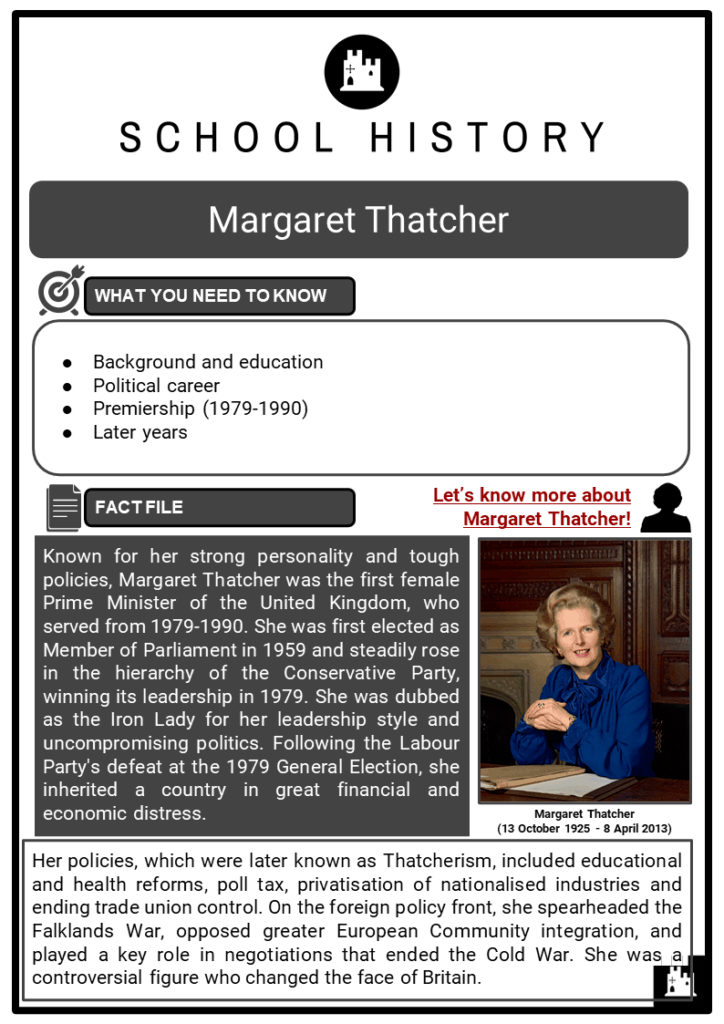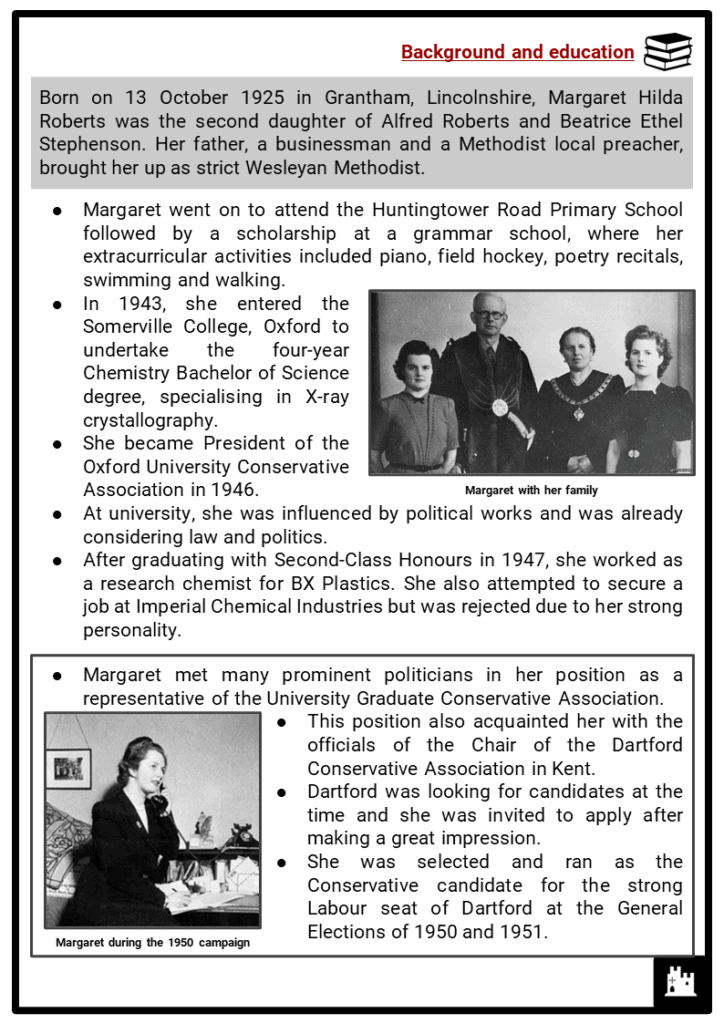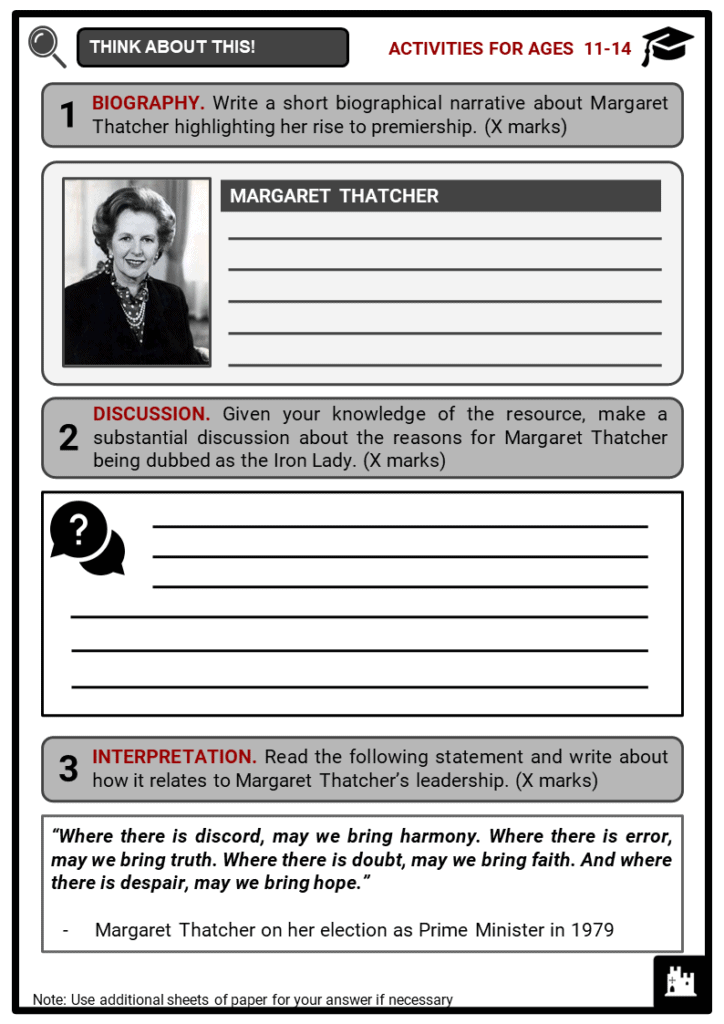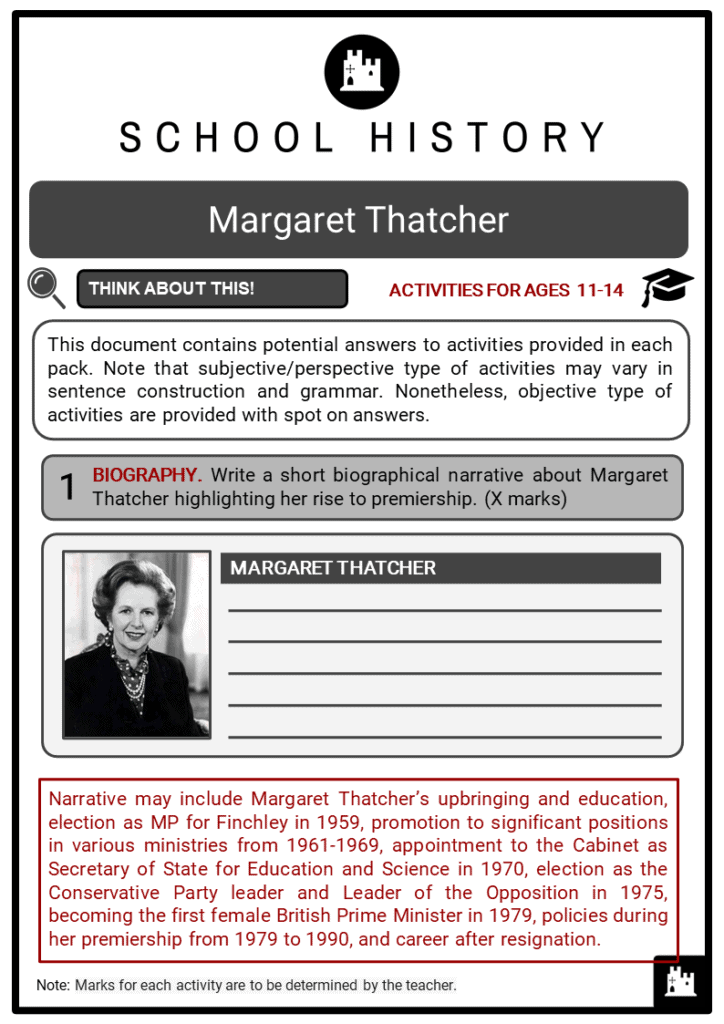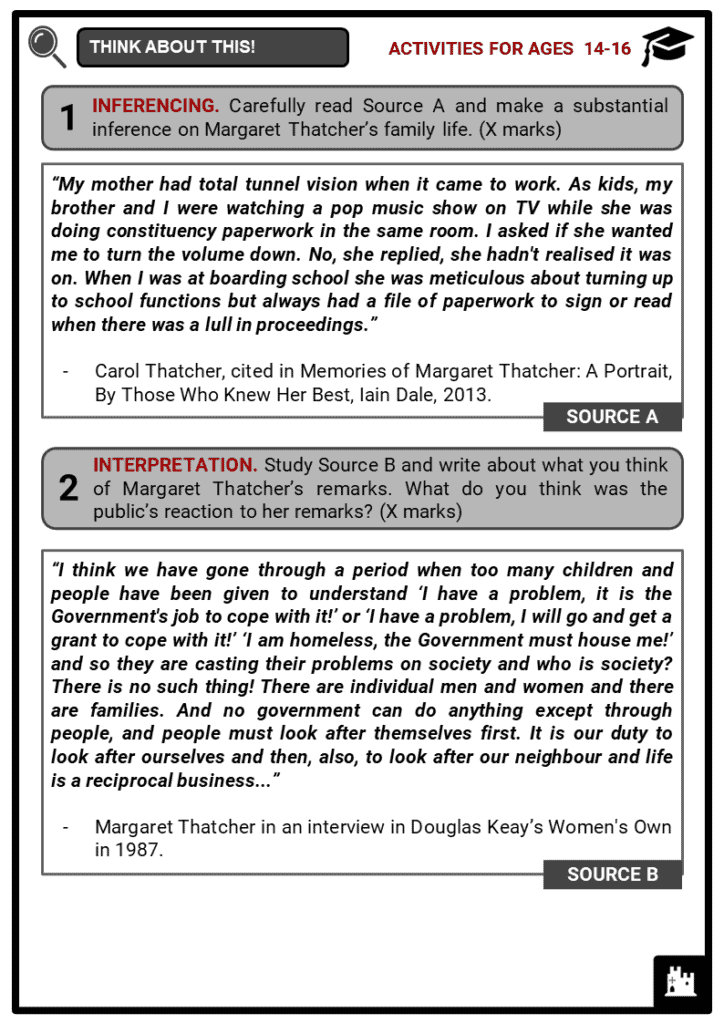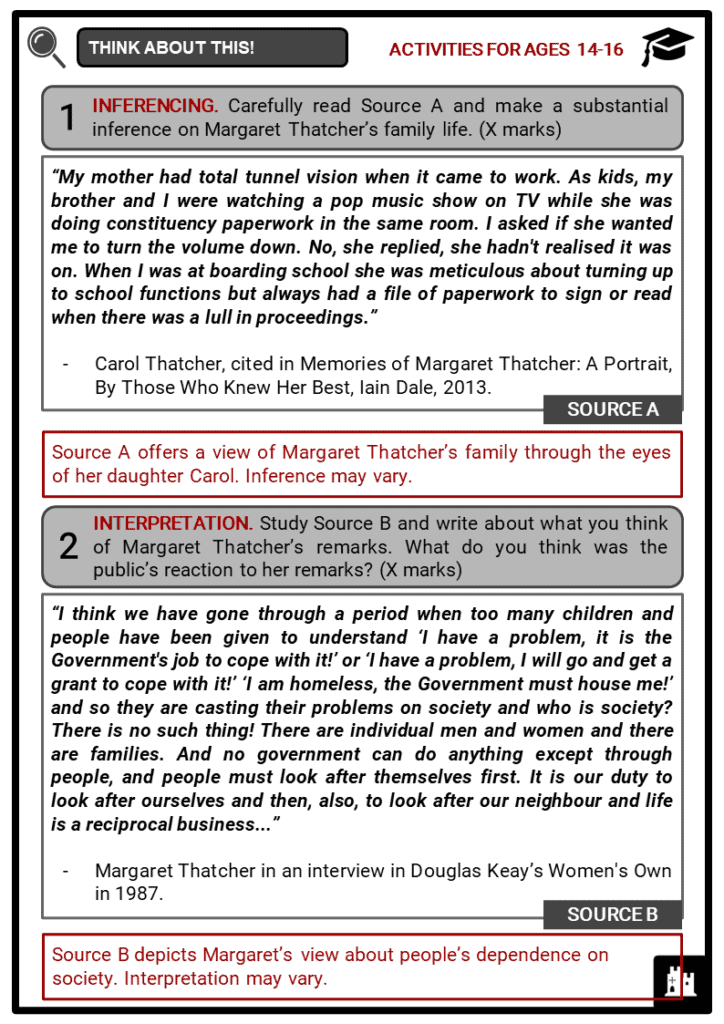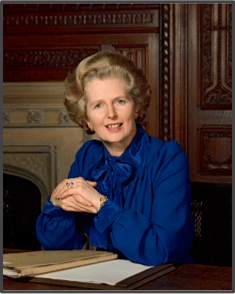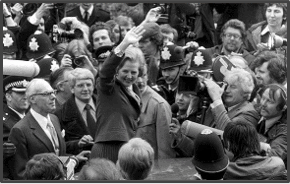Download Margaret Thatcher Worksheets
Do you want to save dozens of hours in time? Get your evenings and weekends back? Be able to teach Margaret Thatcher to your students?
Our worksheet bundle includes a fact file and printable worksheets and student activities. Perfect for both the classroom and homeschooling!
Table of Contents
Add a header to begin generating the table of contents
Summary
- Background and education
- Political career
- Premiership (1979-1990)
- Later years
Key Facts And Information
Let’s know more about Margaret Thatcher!
- Known for her strong personality and tough policies, Margaret Thatcher was the first female Prime Minister of the United Kingdom, who served from 1979-1990. She was first elected as Member of Parliament in 1959 and steadily rose in the hierarchy of the Conservative Party, winning its leadership in 1979. She was dubbed as the Iron Lady for her leadership style and uncompromising politics. Following the Labour Party's defeat at the 1979 General Election, she inherited a country in great financial and economic distress.
- Her policies, which were later known as Thatcherism, included educational and health reforms, poll tax, privatisation of nationalised industries and ending trade union control. On the foreign policy front, she spearheaded the Falklands War, opposed greater European Community integration, and played a key role in negotiations that ended the Cold War. She was a controversial figure who changed the face of Britain.
Background and education
- Born on 13 October 1925 in Grantham, Lincolnshire, Margaret Hilda Roberts was the second daughter of Alfred Roberts and Beatrice Ethel Stephenson. Her father, a businessman and a Methodist local preacher, brought her up as strict Wesleyan Methodist.
- Margaret went on to attend the Huntingtower Road Primary School followed by a scholarship at a grammar school, where her extracurricular activities included piano, field hockey, poetry recitals, swimming and walking.
- In 1943, she entered the Somerville College, Oxford to undertake the four-year Chemistry Bachelor of Science degree, specialising in X-ray crystallography.
- She became President of the Oxford University Conservative Association in 1946.
- At university, she was influenced by political works and was already considering law and politics.
- After graduating with Second-Class Honours in 1947, she worked as a research chemist for BX Plastics. She also attempted to secure a job at Imperial Chemical Industries but was rejected due to her strong personality.
- Margaret met many prominent politicians in her position as a representative of the University Graduate Conservative Association.
- This position also acquainted her with the officials of the Chair of the Dartford Conservative Association in Kent.
- Dartford was looking for candidates at the time and she was invited to apply after making a great impression.
- She was selected and ran as the Conservative candidate for the strong Labour seat of Dartford at the General Elections of 1950 and 1951.
- Margaret was employed as a research chemist for J. Lyons and Co. during the preparation for the elections.
- Although she lost both elections, she gained popularity as the youngest female candidate in the country and enjoyed the experience of campaigning.
- In 1951, she married Dennis Thatcher, who aided the funding for her studies for the bar.
- In 1953, she qualified as a barrister and specialised in taxation.
- She gave birth to twins, Mark and Carol, later that year.
Political career
- After defeat in the selection of Conservative candidate for the Orpington by-election, Margaret focused on her children and stepped back from the 1955 General Election. She was eventually chosen as the candidate for Finchley in April 1958.
- After campaigning in the 1959 election, she was elected as Member of Parliament (MP) for Finchley, a north London constituency, which she continued to represent until she was made a member of the House of Lords as Baroness Thatcher in 1992.
- In 1961, she was appointed to the frontbench as Parliamentary Undersecretary at the Ministry of Pensions and National Insurance by Prime Minister Harold Macmillan, which made her the youngest woman in history to receive such as post.
- She went on to become a spokeswoman for Housing and Land in 1964 and moved to the Shadow Treasury team in 1966.
- In 1967, Margaret was chosen by the United States Embassy to participate in the International Visitor Leadership Program, previously known as the Foreign Leader Program, after recognising her potential as a leader.
- The exchange programme enabled her to spend about six weeks visiting various cities and institutions, and meeting political figures in the US.
- Following the opportunity granted by the programme, Edward Heath appointed her to the Shadow Cabinet as Fuel and Power spokesperson.
- She was then promoted to the Shadow Transport.
- As the Shadow Transport spokesperson, she made her first visit to the Soviet Union in 1969 and delivered her first Commons speech highlighting the need for investment in British Rail.
- Following the victory of the Conservative Party led by Edward Heath in the 1970 General Election, Margaret was appointed to the Cabinet as Secretary of State for Education and Science.
- Due to the speed in which she effected changes following her appointment, student radicalism and opposition to her policies were at its peak in the early 1970s.
- Despite the protests and general disappointment of many with the Heath Government, she was able to manage the position.
- Some of her policies as Education Secretary included:
- Withdrawal of the Labour's Circular 10/65 and drafting of Circular 10/70, which would allow the Local Education Authorities (LEAs) to decide the future of Secondary Education in the area under their authority independently of central government
- Priority given to academic needs in schools
- Abolition of free milk for schoolchildren aged seven to eleven due to expenditure cuts
- Creation of more comprehensive schools, allowing accessible rigorous academic education to working-class children
- Defeated at two successive elections in 1974, Heath's leadership of the Conservative Party was challenged by Margaret, who was still low in the party hierarchy.
- With the support of the Conservative right wing, she won the first and second ballot.
- She was elected the Conservative Party leader and Leader of the Opposition on 11 February 1975, becoming the first woman ever to lead a Western political party and to serve as Leader of the Opposition in the House of Commons.
- With the intention to promote neoliberal economic and foreign policies, Margaret undertook visits across the Atlantic.
- This was followed by trips to meet foreign leaders including in the US and Iran.
- In 1976, a Soviet journalist dubbed her the Iron Lady because of her uncompromising politics and leadership style, a nickname she later embraced.
- Whilst the Labour Government led the country to a state of virtual bankruptcy in 1976, the economy started to recover in mid-1978.
- Labour was in the lead and could possibly be re-elected.
- However, public opinion turned against Labour during the winter of 1978-79, known as the Winter of Discontent.
- A general election was called in early 1979, which was won by the Conservatives with a parliamentary majority of 44.
- Margaret Thatcher became the first female Prime Minister of the United Kingdom.
Premiership (1979-1990)
- Having led the Conservative Party since 1975, Margaret was first elected as the Prime Minister of the UK in 1979 and won landslide re-elections in 1983 (144-seat majority) and 1987 (102-seat majority). She gained intense media attention as a female leader, sharing the spotlight with Queen Elizabeth II and Diana, Princess of Wales.
FIRST TERM
- Economic policies
- Increase in interest rates to slow the growth of the money supply
- Increase in value-added tax (VAT) to 15%
- Reduction or elimination of some governmental regulations and subsidies to businesses
- Foreign relations
- Foreign secretary Lord Carrington brokered the Lancaster House Agreement of December 1979 in Rhodesia, which resumed British control of the state, declared a ceasefire, ended guerrilla action, and quickly led to the creation of the Republic of Zimbabwe.
- In the 1980 siege of the Iranian embassy in Princes Gate, London, six gunmen holding several hostages were successfully suppressed by Special Air Service commandos.
- During the Falklands War in 1982, a British naval task force was despatched to retake the islands. When diplomatic initiatives failed, military action restored British control in the territory.
- Whilst Margaret's first term became deeply unpopular, the victory in the Falklands inspired a wave of patriotic enthusiasm, contributing to her re-election in 1983.
SECOND TERM
- Domestic affairs
- Trade union
- She reduced the power of the unions to prevent strikes that could possibly bring the country to a standstill.
- She enacted laws that banned the closed shop, required unions to poll their members before ordering a strike, forbade sympathy strikes, and rendered unions responsible for damages caused by their members.
- In 1984, the National Union of Mineworkers organised a nationwide strike that lasted nearly a year to prevent the closing of 20 coal mines that the government claimed were unproductive.
- Margaret declined to meet the union’s demands, and the miners were forced to return to work without winning a single concession.
- Privatisation of industry
- She emphasised the importance of reducing state intervention.
- State-owned industries and public services, including aerospace, television and radio, gas and electricity, water, the state airline, and British Steel were privatised.
- She encouraged people to buy their own homes and to make private pension provisions.
- By the end of the 1980s, the number of individual stockholders had tripled.
- The government had sold 1.5 million publicly owned housing units to their tenants.
- Over time, property ownership and private pension plans have greatly increased the personal wealth of the British population.
- British policy in Northern Ireland
- Margaret and many of her cabinet were targeted by the Irish Republican Army (IRA) in 1984, due to her refusal to meet their political demands particularly during the 1980-81 prison hunger strike.
- During the Conservative Party annual conference, her hotel in Brighton was bombed.
- Whilst she survived the assassination attempt, some of her closest colleagues were among the injured and dead.
- In 1985, she signed the Anglo-Irish Agreement with the Republic of Ireland, with the intention of improving security cooperation between Britain and Ireland and to give some recognition to the political outlook of Catholics in Northern Ireland.
- This angered the Northern Irish unionists but was applauded by the Reagan administration and the US Congress.
- Foreign relations
- During the the Cold War, Margaret backed US President Ronald Reagan's policies of rollback against the Soviets and allowed the American forces to station nuclear cruise missiles at British bases. Furthermore, she played a major role in the negotiation of the Intermediate-Range Nuclear Forces Treaty (INF) of 1987, an arms control agreement between the US and the Soviet Union.
- Margaret initially opposed the economic sanctions imposed on South Africa by the Commonwealth and the European Economic Community (EEC) but agreed on peaceful negotiations to end apartheid. She tried to preserve trade with South Africa whilst convincing the government there to abandon apartheid. However, she was obliged to impose limited sanctions and to organise a contact group to promote a dialogue with Pretoria at a Commonwealth summit in October 1985.
- At the Dublin European Council in November 1979, Margaret argued that the United Kingdom paid far more to the EEC than it received in spending. This resulted in the EEC agreeing an annual rebate for the UK amounting to 66% of the difference between British contributions to the community and receipts at the June 1984 Fontainebleau Summit, amidst fierce opposition.
- Margaret and the French President François Mitterrand agreed on the Channel Tunnel project that would build a tunnel under the English Channel linking England to France. They organised study groups and final decisions were announced in 1986.
THIRD TERM
- Margaret's legislative platform for her third term was ambitious with some reforms that became controversial.
- Education
- With the Education Reform Act of 1988, a number of high-profile initiatives were introduced.
- Taxation
- The Community Charge of 1989, or poll tax as it was dubbed by opponents, was a system of taxation which provided for a single flat-rate per-capita tax on every adult, at a rate set by the local authority.
- Health
- After a review of the National Health Service, the National Health Service & Community Care Act (in England) in 1990 separated purchasers and providers within the NHS, which encouraged competition and increased the scope for effective management.
- Her policies came to be known as Thatcherism, which represented a systematic and decisive overhaul of the post-war consensus. It was generally in support of the welfare state, whilst proposing to rid it of abuses.
- The education and health reforms proved efficient and lasting, however the implementation of the Community Charge triggered outbreaks of protest.
- As local councils took advantage of the new system of taxation to increase tax rates, it became a serious political problem.
- The public disapproval of the poll tax and the profound disagreement within the government over policy towards the European Community led to Conservative members of parliament deserting Margaret's leadership.
- Michael Heseltine mounted a challenge for the leadership of the Conservative Party.
- Whilst Margaret led the first ballot with four votes short of the required 15% majority, she was forced to withdraw, stepping down from her position as Conservative Party leader and Prime Minister on 28 November 1990.
- John Major took over and led the party to a fourth successive victory on 9 April 1992.
Later years
- After her resignation, Margaret returned as a constituency parliamentarian and eventually retired from the House of Commons at the 1992 General Election. Whilst in retirement, she continued to be a political force.
- She organised the Margaret Thatcher Foundation supporting free enterprise and democracy, and wrote two volumes of memoirs.
- She accepted speaking engagements and gave lectures, notably in the United States and Asia.
- By 2002, she was advised against engaging in further public speaking by her doctors following several small strokes.
- It was revealed that she had been showing symptoms of progressive dementia since 2000.
- At the age of 87, Margaret died on 8 April 2019 after suffering a stroke at a suite in the Ritz Hotel in London. Her ashes were interred in the grounds of the Royal Hospital Chelsea, next to those of her husband.
Image sources:

